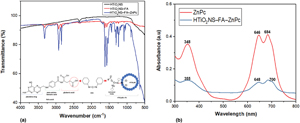Article contents
TiO2 hollow nanospheres functionalized with folic acid and ZnPc for targeted photodynamic therapy in glioblastoma cancer
Published online by Cambridge University Press: 14 November 2019
Abstract

Glioblastoma (GBM) is one of the most aggressive types of cancer which currently does not have a cure. Its invasive nature and heterogeneity makes its complete surgical removal impossible. Hence, a targeted treatment is critically needed to effectively eradicate this cancer. In this work, the authors report the synthesis of hollow TiO2 nanospheres (HTiO2NS) and their functionalization with folic acid (FA) and zinc (II) tetranitrophthalocyanine (ZnPc) to achieve cell selectivity and light absorption in the visible range. In vitro cytotoxicity of the functionalized HTiO2NS against M059K cell line (Human GBM cancer cells) was tested. In vitro generation of reactive oxygen species by HTiO2NS–FA–ZnPc nanostructures under UV irradiation was detected by fluorescence probing. To identify HTiO2NS–FA–ZnPc cell localization, the nanoparticles were labeled with fluorescein isothiocyanate dye and visualized by fluorescence microscopy. Results illustrate that HTiO2NS–FA–ZnPc nanostructures have the potential to be used for targeted photodynamic therapy for the treatment of GBM cancer.
- Type
- Research Letters
- Information
- Copyright
- Copyright © Materials Research Society 2019
References
- 7
- Cited by



